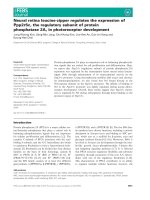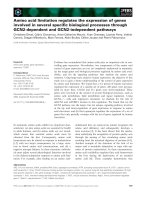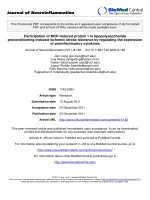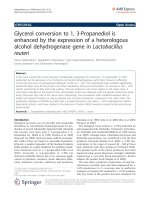Sphingosine kinase 1 regulates the expression of proinflammatory cytokines and nitric oxide in activated microglia
Bạn đang xem bản rút gọn của tài liệu. Xem và tải ngay bản đầy đủ của tài liệu tại đây (959.71 KB, 109 trang )
SPHINGOSINE KINASE 1 REGULATES THE
EXPRESSION OF PROINFLAMMATORY
CYTOKINES AND NITRIC OXIDE IN ACTIVATED
MICROGLIA
DR DEEPTI NAYAK, MBBS
A THESIS SUBMITTED
FOR THE DEGREE OF MASTER OF SCIENCE
DEPARTMENT OF ANATOMY
YONG LOO LIN SCHOOL OF MEDICINE
NATIONAL UNIVERSITY OF SINGAPORE
SINGAPORE
2010
Acknowledgements
I am deeply indebted to my supervisors, Dr S. Thameem Dheen,
Associate Professor, Department of Anatomy, National University of
Singapore, for his constant guidance and patience throughout this study, and to
Professor Ling Eng Ang, Department of Anatomy, National University of
Singapore, for his constant support, suggestions and encouragement.
I would like to acknowledge my gratitude to Mdm Du Xiao Li, Dr
Viswanathan Sivakumar, Mrs. Ng Geok Lan and Mrs Yong Eng Siang for
their invaluable technical assistance and Mdm Carolyne Wong, Ms Violet
Teo and Mdm Diljit Kour for their secretarial assistance. I would also like to
thank Kwang Wei Xin Timothy for contributing figure plate 2 (A-F).
I also wish to thank all staff members and my fellow students at
Department of Anatomy, National University of Singapore for their assistance
and encouragement.
I would like to thank National University of Singapore for the
Research Scholarship and National Medical Research Council for the research
grant (NMRC/1113/2007) to A/P Dheen, without which this study would not
i
have been possible.
Finally but not the least, I am greatly indebted to my husband, Anant
Joshi for his constant encouragement, patience and support during my study
and also to my son Vedant for all the fun, love and joy he has brought to my
life.
ii
This thesis is dedicated to my husband and my son
iii
Publications
The results of this study have been published:
Nayak*, Deepti, Yingqian Huo, Wei Xin Timothy Kwang, Pushparaj Peter
Natesan, S D Kumar, E A Ling and S T Dheen*, "Sphingosine kinase 1
regulates the expression of proinflammatory cytokines and nitric oxide in
activated microglia". Neuroscience, 166 (2010): 132-144. (United Kingdom).
Conference abstract:
Deepti, N, S D Kumar, S S W Tay, E A Ling and S T Dheen*, "Sphingosine
kinase signaling mediates the activation of microglia by inducing
proinflammatory cytokines ". 2008 Neuroscience Meeting Planner (2008):
356.13/BB28. Online: Society for Neuroscience. (Neuroscience 2008, 15 - 19
Nov 2008, Washington Convention Centre, Washington DC, United States)
iv
Table of Contents
Acknowledgements ....................................................................................... i
Publications................................................................................................. iv
Table of Contents..........................................................................................v
Summary ................................................................................................... viii
List of Tables ................................................................................................x
Abbreviations.............................................................................................. xi
Chapter 1: Introduction ...............................................................................1
1.1 The central nervous system ................................................................2
1.2 Microglia: history and types ...............................................................2
1.3 Origins of microglia ...........................................................................4
1.4 Functions of microglia .......................................................................5
1.5 Sphingolipids .....................................................................................7
1.6.1 Types and Location ..................................................................10
1.6.2 Activation of SphKs .................................................................11
1.6.3 Functions of SphK1 and S1P ....................................................12
1.6.4 Clinical significances of sphingolipid pathways ........................15
1.7 Aims and hypothesis of this study .......................................................18
1.7.1 Aims of this study .....................................................................18
1.7.2 Hypothesis ...............................................................................19
v
Chapter 2: Materials and Methods ............................................................20
2.1 Cell culture ......................................................................................21
2.1.1 Materials ...................................................................................21
2.1.2 Procedure ..................................................................................21
2.2 Treatment of cell culture ..................................................................22
2.2.1 Materials ...................................................................................22
2.2.2 Procedure ..................................................................................22
2.3 RNA extraction & Reverse transcription polymerase chain reaction
(RT-PCR) .................................................................................................23
2.3.1 Principles ..................................................................................23
2.3.1.1 RNA extraction ..................................................................23
2.3.1.2 RT-PCR .............................................................................24
2.3.2 Materials ...................................................................................27
2.3.3 Procedure ..................................................................................27
2.3.3.1 RNA extraction procedure from BV2 cells .........................27
2.3.3.2 Procedure for cDNA synthesis ............................................28
2.3.3.3 Procedure for real time polymerase chain reaction (RT-PCR)
29
2.4 Western immunoblot assay...............................................................30
2.4.1 Principles ..................................................................................30
2.4.2 Materials ...................................................................................31
2.4.3 Procedure ..................................................................................34
2.5 Immunofluorescence ........................................................................35
2.5.1 Principles ..................................................................................35
2.5.2 Materials ...................................................................................35
2.5.3 Procedure ..................................................................................36
2.6 siRNA gene silencing ......................................................................37
2.6.1 Principles .....................................................................................37
2.6.2 Materials ......................................................................................38
2.6.3 siRNA sequences .........................................................................38
2.6.4 Procedure for siRNA silencing of SphK1 .....................................39
2.7 ELISA.............................................................................................40
2.7.1 Principles .....................................................................................40
2.7.2 Materials ......................................................................................41
2.7.3 Procedure for TNF-α quantification by ELISA ............................41
2.8 Nitric Oxide Assay ..........................................................................42
2.8.1 Principles .....................................................................................42
2.8.2 Materials ......................................................................................43
2.8.3 Procedure .....................................................................................43
Chapter 3: Results ......................................................................................44
3.1
SphK1 is expressed in microglial cells .............................................45
vi
3.2
3.3
S1P receptors 1-5 are expressed in BV2 microglial cell line .............45
Expression of SphK1 is increased in activated microglia ..................45
3.4 Suppression of SphK1 by DMS reduced the TNF-α production.......46
3.5 Exogenous administration of S1P in BV2 microglia increased the
TNF-α production ....................................................................................46
3.6 Suppression of SphK1 by siRNA reduced TNF-α production in LPS
activated microglia....................................................................................47
3.7 Suppression of SphK1 by DMS reduced the mRNA expression level
of IL-1β in BV2 microglia .......................................................................48
3.8 Exogenous administration of S1P in BV2 microglia increased the IL1β mRNA expression ...............................................................................49
3.9 Suppression of SphK1 (SphK1-) by siRNA reduced IL-1β mRNA
expression in LPS- activated microglia .....................................................49
3.10 SphK1 regulates the iNOS mRNA expression in activated BV2
microglia ..................................................................................................50
3.11 Suppression of SphK1 (SphK1 -) by siRNA reduced the iNOS mRNA
expression in LPS-activated microglia. .....................................................50
3.12 SphK1 regulates NO production in BV2 microglial cells ................51
Chapter 4: Discussion .................................................................................52
4.1
Conclusion and scope for future study..............................................58
References ...................................................................................................61
Figure Plates and Legends .........................................................................72
vii
Summary
Microglia, the resident immune cells of the central nervous system
(CNS), play a pivotal role in the pathway leading to various neurodegenerative
diseases including Alzheimer’s disease, Parkinson’s disease, prion diseases
and HIV-dementia. Activation of microglial cells causes neurotoxicity through
the release of a wide array of inflammatory mediators including
proinflammatory cytokines, chemokines and reactive oxygen species.
Microglial activation has been implicated as one of the causative factors for
neuroinflammation
in
various
neurodegenerative
diseases.
Therefore,
suppression of microglia-mediated inflammation has been considered as an
important therapeutic strategy for neurodegenerative diseases.
The sphingolipid metabolic pathway plays an important role in
inflammation, cell proliferation, survival, chemotaxis, and immunity in
peripheral macrophages. In this study, we demonstrate that sphingosine
kinase1 (SphK1), a key enzyme of the sphingolipid metabolic pathway, and its
receptors are expressed in the BV2 microglial cells and SphK1 alters the
expression and production of proinflammatory cytokines and nitric oxide in
microglia treated with lipopolysaccharide (LPS). LPS treatment increased the
SphK1 mRNA and protein expression in microglia as revealed by the RTPCR, Western blot and immunofluorescence. Suppression of SphK1 by its
viii
inhibitor, N, N Dimethylsphingosine (DMS), or siRNA resulted in decreased
mRNA expression of TNF-α, IL-1β, and iNOS and release of TNFα and nitric oxide (NO) in LPS-activated microglia. However, addition of
sphingosine 1 phosphate (S1P), a breakdown product of sphingolipid
metabolism, restored the increased expression levels of TNF-α and IL-1β and
production of TNF-α and NO in activated microglia exposed to DMS or
transfected with SphK1 siRNA. Hence, to summarize, suppression of SphK1
in activated microglia inhibits the production of proinflammatory cytokines
and NO, and the addition of S1P to microglia reverses the suppressive effects.
Since the chronic proinflammatory cytokine production by microglia has been
implicated in neuroinflammation, modulation of SphK1 and S1P in microglia
could be looked upon as a future potential therapeutic method in the control of
neuroinflammation in neurodegenerative diseases.
ix
List of Tables
Table 1: Primer sequences used .................................................................29
Table 2: Reagents used for Western Blotting ............................................32
Table 3: siRNA sequences ..........................................................................39
x
Abbreviations
ΒΒΒ − Blood brain barrier
bp- basepairs
CNS- Central nervous system
DAPI- 4'-6-Diamidino-2-phenylindole
DMEM- Dulbeco’s modified eagles medium
DMS- N, N Dimethylsphingosine
ELISA- Enzyme-linked immunosorbent assay
FBS- Fetal bovine serum
HRP- Horseradish peroxidase
IF- Immuofluorescence
IFN-γ−Interferon γ
IL-1β - Interleukin 1β
IL-1R1- Interleukin-1 receptor type 1
iNOS- inducible nitric oxide synthetase
kD-kiloDalton
LPS- Lipopolysaccharide
NO- Nitric oxide
PBS- Phosphate buffered saline
RT-PCR- Reverse transcription polymerase chain reaction
xi
SE- Standard error
SphK1, 2- Sphingosine kinase 1 and 2
S1P- Sphingosine-1-phosphate
TE- Trypsin-EDTA
TMB-Tetramethylbenzidine
TNF-α- Tumour necrosis factor α
TNFR1 or 2 – TNF-α receptor type 1or 2
FTY720- Fingolimod
xii
Chapter 1: Introduction
1
1.1 The central nervous system
The central nervous system (CNS) consists of the brain and spinal
cord. Microscopically, the brain has around 1-2 x 10 11 neurons and many more
glial cells (namely-oligodendrocytes, astrocytes, microglia and ependymal
cells). The glial cells are capable of dividing mitotically throughout life in
contrast to the neurons and are derived from the ectoderm with the exception
of the microglia, which is of monocytic lineage. The glial cells are separated
from the neurons in the CNS by extracellular fluid by about 10-20nm
intercellular space, which comprises about 15-20% of the brain volume. The
glial cells do not participate in generating action potentials and have no
synapses. The glial cells are subdivided into macroglia and microglia. The
macroglia consist of the astrocytes and oligodendrocytes (Noback, 2005).
1.2 Microglia: history and types
Microglial cells were first described by Franz Nissil (Nissil, 1899) as
rod cells, whose function was considered to be similar to leukocytes. Ramon
Y Cajal (Cajal, 1913) described microglial cells as the ‘third element’ of the
CNS, which refers to a group of cells that are morphologically distinct from
the first and second elements, namely neurons and astrocytes. Del RioHortega (P. Río-Hortega, 1920) differentiated this third element into microglia
2
and oligodendrocytes and was also the first to describe the two types of
microglia: amoeboid and ramified.
Microglia, comprising 10-20% of the total glial cell population of the
CNS, are the resident macrophage cells within the entire neuroaxis and
represent the primary immunocompetent cells that protect against invasions by
various routes, be it infectious agents or tumours. True to their macrophage
nature, they also remove cellular debris from within the CNS. Thus they act as
vigilant guardians of the brain and spinal cord. Although similar to peripheral
macrophages,
they
possess
distinguishing
electrophysiological
and
biochemical properties, which make microglia different from the macrophages
(Squire, 2008).
Microglia
contain
lysosomes
and
vesicles
characteristic
of
macrophages, a sparse endoplasmic reticulum and a few cytoskeletal fibers
(Squire, 2008). They usually have small rod shaped somas from which
numerous processes extend (Squire, 2008). Processes from different microglia
rarely overlap or touch (Squire, 2008). They are found in the CNS within the
parenchyma (parenchymal microglia), and in the circumventricular organs.
Microglia exist in different morphological and functional forms
(Noback, 2005):
•
Resting ramified microglia: They are known as the resident brain
macrophages and found in the normal adult CNS. They have finely
branched and ramified processes (Noback, 2005).
3
•
Activated amoeboid or reactive nonphagocytic microglia: They are
found in areas of secondary reaction as in nerve transection and in
CNS inflammation and are capable of producing cytokines (Noback,
2005).
•
Phagocytic microglia or reactive phagocytic microglia: They are found
in areas of trauma, infection and neuronal degeneration (Noback,
2005).
1.3 Origins of microglia
Microglia are of myelomonocytic lineage and are derived from
hemangioblastic mesoderm. They become part of the CNS parenchyma during
early embryonic development around the time when neurulation is completed
(Streit, 2001). The fetal macrophages (Takahashi, et al., 1989) are known to
populate the developing neuroectoderm as early as the 8 th embryonic day in
rodents (Alliot, et al., 1999). These fetal macrophages are considered to be the
earliest detectable microglial precursor cells. With the further development of
the CNS in the embryo, the fetal macrophages change from their rounded
shape to embryonic microglia, which have short processes. At the perinatal
stage, the embryonic microglia change into amoeboid microglia and these
cluster around the supraventricular corpus callosum (Hurley, et al., 1999, Ling
and Wong, 1993). The amoeboid microglia persist in the corpus callosum for
the first two postnatal weeks, migrate into the cerebral cortex and differentiate
into fully ramified microglia. A few microglia may also be replaced by
4
perivascular (space around the medium and small sized cerebral vessels) cells
which are mononuclear phagocytes, replaced continuously by bone marrow
progenitors (Hickey and Kimura, 1988),
1.4 Functions of microglia
Microglia are involved in clearance of apoptotic cells (Polazzi and
Contestabile, 2002) during brain remodeling in embryogenesis and also brain
remodeling through their assistant role in synapse stripping and matrix
reorganization (Harry and Kraft, 2008). They also participate in the induction
of neuronal death in cerebellum during normal development (Marin-Teva, et
al., 2004). In the adult brain, microglia are in intimate contact with neurons
and serve important maintenance functions and are capable of responding to
subtle changes in the microenvironment, (Alemany, et al., 2007, Davalos, et
al., 2005, Kreutzberg, 1996, Nimmerjahn, et al., 2005, Raivich, 2005) These
cells play a major role in phagocytosis and clearance of aberrant or excess
proteins e.g. β amyloid (Harry and Kraft, 2008).
In the CNS injury, microglia actively monitor and control the
extracellular environment, walling off areas of the CNS from non-CNS tissue,
and remove degenerating and dysfunctional cells (Harry and Kraft, 2008). The
activated microglia in response to CNS inflammation secrete proinflammatory cytokines such as TNF-α and IL-1β and serve as antigen
presenting cells (Carson, et al., 1998, Carson and Sutcliffe, 1999, Frei and
Fontana, 1997, Hickey and Kimura, 1988) Increases in TNF-α and IL-1β have
5
been observed prior to neuronal death (Harry, et al., 2008, Lefebvre
d'Hellencourt and Harry, 2005, Matusevicius, et al., 1996) and recent studies
suggest that the activation of pro-inflammatory factors such as TNF-α can
participate in causation of neuronal death (Harry and Kraft, 2008, Harry, et al.,
2008, Kaushal and Schlichter, 2008). In adddtion, microglia produce multiple
secreted factors including pro- and anti-inflammatory cytokines, nitric oxide,
reactive oxygen species (ROS), glutamate, and growth factors (Harry and
Kraft, 2008). Microglia also express the glutamate transporter, GLT-1 and,
thus, may provide a level of protection through the elimination of extracellular
glutamate (Nakajima, et al., 2001). Microglia can facilitate the apoptosis and
phagocytosis of infiltrating T cells through various signaling pathways leading
to a subsequent down regulation of microglial immune activation (Magnus, et
al., 2002)
Ageing leads to neurodegeneration which might not only be due to a
loss of neuroprotective properties, but also the actual loss of microglia (Ma, et
al., 2003). This loss of microglia in senescence appeared to be caused by
increased intracellular accumulation of iron leading to intracellular oxidative
damage (Streit, et al., 2008).
The mechanisms by which the myriad functions and actions of
microglia take place need to be studied in order to understand and apply it in
possible therapeutic modulations. Hence in vitro studies are conducted by
activating microglia by various stimuli such as LPS, β-amyloid, and IFN-γ,
thrombin and proinflammatory cytokines. LPS, which is an endotoxin, is one
6
of the components of the outer membrane of gram negative bacteria and is an
activator of microglia. LPS has been shown to activate the microglia by
crossing the blood-brain barrier (BBB) in areas of loss of structural integrity
of the BBB. Such an activation of microglia leads to the expression of
proinflammatory cytokines, chemokines and reactive oxygen species that
modulate inflammation. The endogenous receptor CD14 on microglial cells is
the target for the LPS (Rivest, 2003).
β-amyloid which are present in neurofibrillary tangles and senile
plaque in the brain of Alzheimer’s disease patients, are known to be
surrounded by reactive microglia indicating its potential role in the disease
process (Dheen, 2007). Microglia activated by β-amyloid have been known to
express proinflammatory cytokines and chemokines such as IL-1β, IL-8, IL10, IL-12, TNF-α etc (Dheen, 2007).
IFN-γ is another known activator of microglial cells and serves
important functions in innate and adaptive immunity (Dheen, 2007). Microglia
in murine models show significantly increased myelin phagocytosis,
proteolytic enzyme secretion and oxidative stress in response to IFN-γ (Dheen,
2007).
1.5 Sphingolipids
Lipids account for approximately 10% of the weight of the wet brain
and half the dry matter of the brain (Sastry, 1985). The complex lipids are of
7
two types- glycerolipids and sphingolipids. The sphingolipids contain the long
chain amino alcohol, sphingosine. The sphingolipids are derived from
ceramide, which occurs in large concentrations in the nervous tissue and they
include sphingomyelins, cerebrosides, sulfatides and gangliosides (Sastry,
1985).
Sphingomyelin accounts for 4.2-12.5% of the phospholipid content of
the brain in various species. The peripheral nerves and the white matter have a
higher concentration of sphingomyelin which forms a major component of
myelin membrane (Sastry, 1985).
The production and metabolism of sphingolipids occur via de novo
synthesis and the salvage pathway. The endoplasmic reticulum is the site for
the de novo synthesis of sphingolipids. Palmitoyl CoA and serine get
condensed to form 3-ketosphinganine in the presence of the catalytic action of
serine palmitoyl transferase. Next, the 3-ketosphinganine is then reduced by a
NADH dependant reductase to produce dihydrosphingosine. Ceramide
synthase
then
adds different
lengths
of
acyl
chains to
produce
dihydroceramide (Ogretmen and Hannun, 2004). This is subsequently
desaturated via dihydroceramide desaturase to form ceramide. Ceramide is
then phosphorylated by ceramide kinase to ceramide-1-phosphate which is a
bioactive sphingolipid. After ceramide formation, the remaining reactions
occur in the Golgi apparatus and result in the incorporation of ceramide into
glycolipids and sphingomyelin. Sphingolipids can also be recycled and
ceramide
can
be
produced
by
the
salvage
pathway,
in
which
8
glucocerebrosidase and sphingomyelinase breakdown various membrane
glycolipids and sphingolipids. Ceramidases remove acyl chain from ceramide
substrates and form sphingosine. Sphingosine can be recycled back to
ceramide via ceramide synthases or, sphingosine can be phosphorylated to
sphingosine-1-phosphate (S1P) by sphingosine kinases (Hannun and Obeid,
2008, Olivera, et al., 1998). S1P is dephosphorylated by sphingosine-1phosphate phosphatase to form sphingosine. The final step in the biosynthesis
is the irreversible cleavage of S1P into ethanolamine phosphate and
hexadecenal by S1P lyase (Snider, et al., 2010).
Of all the products of sphingolipid synthesis, ceramide, sphingosine and
S1P have been established in cell signaling roles. Ceramide has an important
role in cellular stress responses such as cell cycle arrest, serum and nutrient
deprivation, terminal differentiation, apoptosis and cell senescence (Hannun
and Obeid, 2008). It has also been implicated in inflammation and skin
homeostasis (Snider, et al., 2010). The action of ceramide on inflammation
can be mediated by one of its phosphorylated products ceramide-1-phosphate,
which activates phospholipase A2 (Nakamura, et al., 2006). In addition,
ceramide-1-phosphate is required for the membrane translocation of
phospholipaseA2 and downstream production of PGE2 (Lamour, et al., 2009)
Upon the degradation of ceramide, to sphingosine, S1P is rapidly
formed via phosphorylation which then binds to G protein coupled receptors
(S1P receptors). S1P has been implicated in myriad cell signaling pathways
such as angiogenesis, cell migration and movement, cell survival and
9
proliferation, cellular architecture, cellular contacts and adhesions, heart
development, vascular development, atherogenesis, acute lung injury and
acute respiratory distress, tumourogenecity, metastasis, inflammation and
immunity (Alemany, et al., 2007, Hait, et al., 2006).
1.6 Sphingosine kinases
1.6.1 Types and Location
Two isoforms of SphKs have been characterized so far: SphK1 and
SphK2. In humans, SphK1 is located on chromosome 17 and SphK2 is located
on chromosome 19 (Bryan, et al., 2008). SphK1 is present in the cytosol
(Kohama, et al., 1998) and unlike Sphk1, the localization of SphK2 is cell type
specific (Okada, et al., 2005, Sankala, et al., 2007). Both of the kinases
phosphorylate erythro-sphingosine (Sphingosine), dihydrosphingosine and
phytosphingosine, which are key sphingolipids (Melendez, 2008). In adult
mouse, SphK1 is present abundantly in the spleen, heart, lung and brain,
whereas SphK2 is expressed in the brain, kidney and the liver (Liu, et al.,
2000). SphK1 translocates from the cytosol to the membrane periphery where
it phosphorylates sphingosine into S1P. Sphk1 translocation to the plasma
membrane has been shown to be facilitated by calcium and integrin binding
protein1 (Jarman, et al., 2010). Another possible mechanism for this
translocation is via TNF-α by the means of phospholipase D1 dependant
mechanism in monocytes (Sethu, et al., 2008)
10
Many proteins affecting the activity of SphK1 have emerged, which
include D-catenin/neural plakophilin- related armadillo repeat protein (Fujita,
et al., 2004), aminoacyclase 1(Maceyka, et al., 2004), eukaryotic elongation
factor 1A (Leclercq, et al., 2008), filamin A (Maceyka, et al., 2008),
sphingosine kinase 1-interacting protein (Lacana, et al., 2002), and platelet
endothelial adhesion molecule-1 (Fukuda, et al., 2004). Protein phosphatase
2A has been shown to deactivate SphK1 (Barr, et al., 2008) and cytosolic
chaperonin containing TCP-1 has been shown to mediate proper folding of
SphK1 (Zebol, et al., 2009)
Another mechanism of regulation of SphK1 is at the transcriptional
level, where the SphK1 promoter was shown to be up regulated in response to
LPS in RAW macrophages leading to possible protection from apoptosis
(Hammad, et al., 2006). Hypoxia inducible factor 2α has also been shown to
upregulate SphK1 expression selectively in glial cells, thereby leading to S1P
secretion and enhancement of transcellular angiogenesis (Anelli, et al., 2008).
Exposure of SphK1 to DNA damage, TNFα and proteolysis causes its
downregulation (Taha, et al., 2004).
1.6.2 Activation of SphKs
The SphKs have been shown to be activated by various factors
including (Bryan, et al., 2008): (a) Growth factors -platelet derived growth
factor, epidermal growth factor, vascular endothelial growth factor, nerve
growth factor, basic fibroblast growth factor, transforming growth factor β,
11
and insulin like growth factor-1; (b) Cytokines: TNF-α, interleukins; (c)
Hormones: prolactin and estradiol; (d) Hypoxia, and (e) Histamine.
1.6.3 Functions of SphK1 and S1P
The cellular levels of sphingosine, ceramide and S1P and the
activation/inactivation of SphK1 play major roles in myriad biological
processes. S1P is known to be a modulator of cell proliferation, survival,
apoptosis, migration, and Ca+2 hemostasis (Alemany, et al., 2007).
S1P can act intracellularly as a second messenger and extracellularly
as a ligand for G-Protein coupled receptors coded by endothelial
differentiation genes and are known as S1P receptors (S1P1, S1P2, S1P3,
S1P4, S1P5) (Ozaki, et al., 2003, Rosen and Goetzl, 2005) thereby modulating
cellular processes including proliferation, stimulation of adherent junctions,
enhanced extracellular matrix assembly, formation of actin stress fibers and
inhibition of apoptosis induced by ceramide or growth factor withdrawal
(Alvarez, et al., 2007, Melendez, 2008) . The modulations of these functions
have been studied in peripheral macrophages and other immune cells (Gude,
et al., 2008, Hammad, et al., 2008, Melendez, 2008).
S1P1 signaling is known to be essential for embryonic blood vessel
development (Liu, et al., 2000). S1P has also been shown to elicit egress of
lymphocytes into the blood in an S1P1 dependant manner. S1P2 and S1P3
activate phospholipase-C and Rho and the knockout of both these receptors in
mice decreases litter size and survival rates (Ishii, et al., 2002). Although not
12









